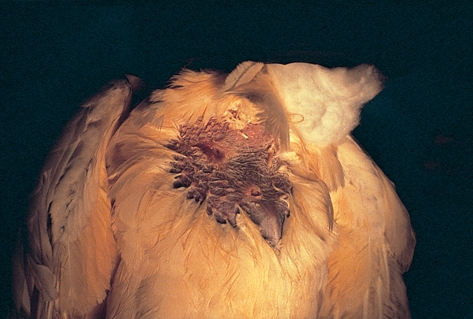Avian Medicine Q&A 13
| This question was provided by Manson Publishing as part of the OVAL Project. See more Avian Medicine questions |
An eight-week-old cockatoo presented as an emergency because the owner noticed food coming from the throat. The bird is still being syringe fed and weaning has not yet been started. The bird is bright, alert and active on presentation.
| Question | Answer | Article | |
| What is your diagnosis? | This bird has a crop fistula, which is characterized by a fistula between the ingluvies (crop) and the skin allowing ingested food to pass out of the ingluvies.
|
Link to Article | |
| What is the most likely aetiology for this condition given the history and physical findings? | The fistula is most likely the result of feeding inappropriately heated food to this baby bird.
Most commonly, the food has been heated in a microwave oven but microwaves do not heat food evenly. Though the temperature of the food is tested and apparently of appropriate temperature, pockets of overly heated food may be present. When the food is syringe or tube fed into the ingluvies, the overheated area remains in contact with and causes thermal burn of the ingluvies. Once the burn has healed and the scab falls off, a fistula remains. In many cases the owner does not notice the original injury and only becomes aware of the problem when food spills from the crop. At this stage, it is not an emergency but is very frightening to most owners. |
Link to Article | |
| How should this condition be managed surgically and what is the longterm prognosis? | Surgical management is usually postponed until the patient is stable and the wound has matured.
In some cases the demarcation between viable and non-viable tissue is readily apparent. In others it may be difficult to distinguish healthy tissue from revitalized tissue. It generally takes 3–5 days from the time of injury for the demarcation to mature. Once it is obvious, the eschar is removed along with any scar tissue uniting the wall of the ingluvies to the skin. The ingluvies is dissected away from the skin to allow the two structures to be closed as separate tissues. The ingluvies is closed in an inverting pattern, if possible, to allow serosa-to-serosa contact. The skin is closed over the crop as a separate layer. In cases with severe damage and necrosis of the ingluvies, every effort is made to maintain the longitudinal integrity of the oesophagus. Resection and anastomosis of the oesophagus and ingluvies are not recommended as the incidence of stricture is much greater. An oesophageal feeding tube may be placed in cases of extensive tissue loss to serve as a stent around which the oesophagus may heal. This will also allow the patient to receive alimentation during the healing period without stressing the repair. |
Link to Article | |
